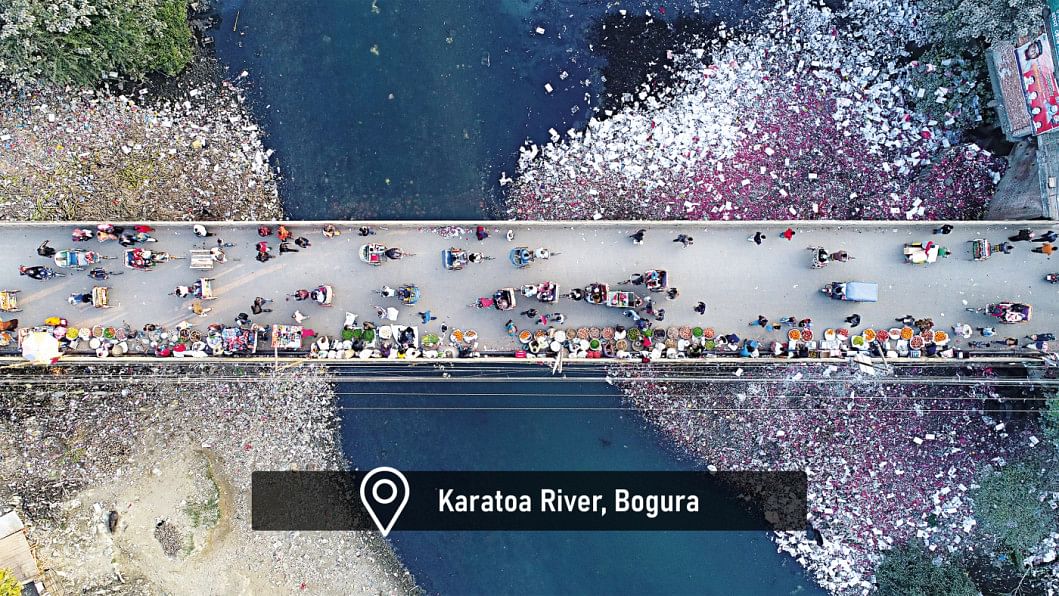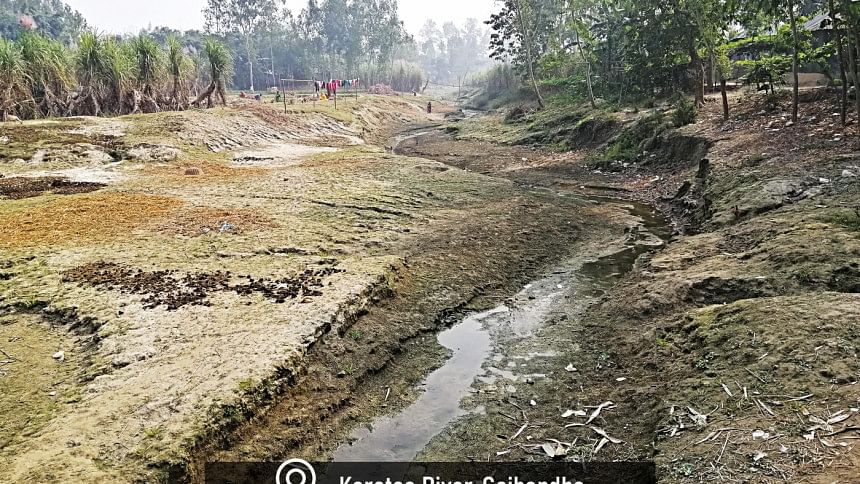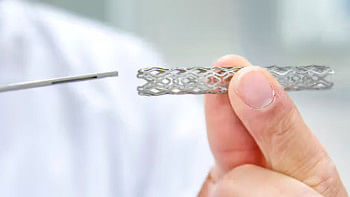Mighty Korotoa a myth now

The once-mighty Korotoa now barely flows through Bogura district.
Issues like unbridled pollution, a regulator that obstructs natural flow, and gradual decrease in water from upstream have almost chocked the river down, said experts and locals.
Over a 100-kilometre stretch of the Korotoa now flows with as less width as a canal in different parts of the district throughout the year.
Originated from the Himalayas, the river enters Bangladesh through Darjeeling and Jalpaiguri districts of West Bengal in India. A section of the Korotoa flows over Bogura via Khalshi village in Gobindaganj upazila of Gaibandha.
During a recent visit to the village, this correspondent found that the river was reduced to what looked like a drain. Many residential establishments were also seen on both banks of the river.
According to locals, the river started drying up after a regulator was constructed at Khalshi village in 1996.
The three-vent regulator was constructed with a hope of preventing floods in the area by controlling the water flow.
Raja Mia Sarkar, a 65-year-old resident of the village, said, “The regulator may have saved the village from floods, but the river gradually dried up.”
“There was a time when hundreds of boats and large vessels used to ply on the river every day,” recollected 78-year-old Montezer Rahman, another resident of the same village.
Contacted, Mahbubul Alam, sub-divisional engineer of Water Development Board (WDB) in Gaibandha, said the authorities set up the regulator at the village to prevent floods in Gobindaganj and its adjacent areas.
“The regulator was a part of Nurulla Beel project,” he added.

He, however, declined to make any comment over the side-effects of the regulator.
Seeking anonymity, a WDB official in Gaibandha said any man-made construction that influences flow of river has side-effects. After the Khalshi regulator was constructed, the downstream or down Korotoa’s bed started rising and silts started filling up “turning the river into a sewerage drain”.
An official of WDB in Bogura, who also sought anonymity, echoed the statement.
Contacted, Mukhlasur Rahman, executive engineer of WDB in Gaibandha, said, “Khalshi regulator has not been used for a single day in the last 15 years.”
Asked about the purpose of the regulator, he kept mum for a few moments.
He then said they prepared a Tk 2,665-crore project to improve the condition of the Korotoa which is now pending at the planning commission for approval.
The three-vent regulator in Khalshi would be replaced by a 10-vent one if the proposed project gets approval. The proposed regulator would increase water flow, he added.
A SAGA OF POLLUTION
The municipality and some non-government organisations are at the top of the river polluters’ list in the district, according to the Department of Environment (DoE) in Bogura.
Ashrafuzzaman, director of the DoE’s Rajshahi Divisional Office, said, “These local-government and non-government organisations have been continuously dumping their waste, both liquid and solid, into the river for years even after repeated warnings.”
Waste from hundreds of hospitals, clinics, diagnosis centres, households, marketplaces, are falling into the river through the sewerage drains of the municipality, he added.
Around three months ago, the DoE served a notice to the municipality mayor to check measures for stopping river pollution. The notice also warned the municipality authorities of legal actions if they did not stop harming the river, he said.
The municipality, however, seem to be paying no heed to the notice, the DoE official further said.
This correspondent, during his visit to different parts of the town, found that liquid and sold wastes, including the plastic waste, were indiscriminately being dumped into the Korotoa through large sewerage drains of the Bogura Municipality.
Contacted, AKM Mahbubur Rahman, mayor of Bogura Municipality, refuted the allegations.
He said, “We are collecting waste from houses, and sending them to the dumping station in Matidali area. Sometimes, residents of the town drop their household waste to the municipality drains and it goes into the river.”
“Our waste management system is better than many other towns,” he added.
About the medical waste, the mayor said the municipality was “not dealing with the medical waste”. There is an NGO called Sapna that maintains the medical wastes, he added.
The mayor, at one point of the conversation, admitted that most of the six lakh residents of the municipality were not complying with their instruction of not connecting their toilets to sewerage drains.
Ziaur Rahman, executive director of Sapna, said they collect only the solid waste of 122 hospitals, clinics and diagnostic centres in the town and dispose them at the Matidali landfill.
GM Suclyan Bitul, secretary of the Bogura District Clinics and Diagnosis Centres Owners Association, said private medical establishments in the town usually collect medical waste in three different bins and give it to Sapna.
At times, some clinics’ staffers may drop their liquid waste into the municipally sewerage drains, but we have strictly forbidden them from doing it.
Mojumder Products Limited, an auto-rice mill that also produces rice bran oil, is another major river polluter in the district. The DoE has fined the company for discharging untreated water into the river.
Admitting that the DoE has fined the company Taka 9.68 lakh in November last year, Ranjan Chakraborty, admin officer of the rice mill, said they were storing the discharged water in a specific place and that they would establish an effluent treatment plant soon.
Ziaur Rahman, secretary of Bangladesh Poribesh Bachao Andolan (BAPA) in Bogura, said they found at least 500 small and large drains, including the municipality’s ones, discharging contaminated and harmful waste into the Korotoa.
CHEMICAL SUBSTANCES JEOPARDISING ECO-SYSTEM
According to the latest water analysis report of the DoE, published in December last year, only 3 to 3.6 mg dissolved oxygen (DO) was remaining in each litre of water at the Korotoa for seven to eight months.
The ratio is three to four times lower than other rivers in Rajshahi division.
The DoE regularly examines water samples at eight points, both upstream and downstream, of the river.
The rate of the dissolved oxygen in river water should ideally be between 4.5 and 8 mg per litre, as per the Environment Conservation Rules, 97.
Moreover, the report shows the presence of chemical oxygen demand (COD) and a lack of biological oxygen demand (BOD) that hampers river’s aquatic lives.
These chemical substances and acidic water are eventually jeopardising the eco-system of the river, said Masud Rana, a chemist at the Bogura environment office.





Comments